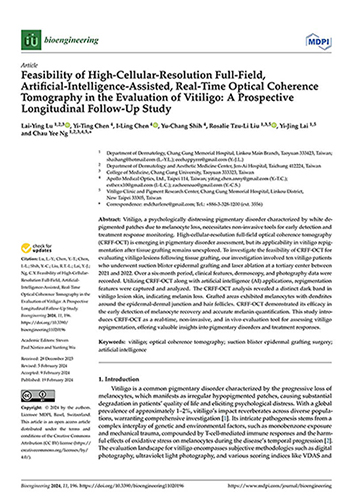研究動態
高細胞分辨率全視場人工智能輔助實時光學同調斷層掃描術在白斑症評估中的可行性:一項前瞻性縱向隨訪研究

摘 要:
白斑症是一種令患者心理壓力巨大的色素性疾病,其特徵是由於黑色素細胞的丟失而在皮膚上出現白色脫色斑塊。針對白斑症的早期檢測和治療反應監測,需要非侵入性工具。高細胞分辨率全視場光學同調斷層掃描術(CRFF-OCT)在色素性疾病評估中日益受到關注,但其在組織移植後白斑症再色素化中的應用尚未得到探索。為了研究 CRFF-OCT 評估組織移植後白斑症病變的可行性,我們對 2021 年至 2022 年期間在一級醫療中心接受水泡表皮移植和雷射磨皮的十名白斑症患者進行了研究。在為期六個月的研究中,記錄了臨床特徵、皮膚鏡檢和攝影數據。利用 CRFF-OCT 和人工智能(AI)應用,捕捉並分析了再色素化特徵。CRFF-OCT 分析顯示,白斑症病變皮膚中出現了一條明顯的黑色帶,表明黑色素流失。移植區域在表皮-真皮交界處和毛囊周圍出現了帶樹突的黑色素細胞。CRFF-OCT 證明其在早期檢測黑色素細胞恢復和準確量化黑色素方面的有效性。本研究介紹了 CRFF-OCT 作為實時、非侵入性和體內評估工具在白斑症再色素化中的應用,為色素性疾病和治療反應提供了寶貴的見解。Vitiligo, a psychologically distressing pigmentary disorder characterized by white depigmented patches due to melanocyte loss, necessitates non-invasive tools for early detection and treatment response monitoring. High-cellular-resolution full-field optical coherence tomography (CRFF-OCT) is emerging in pigmentary disorder assessment, but its applicability in vitiligo repigmentation after tissue grafting remains unexplored. To investigate the feasibility of CRFF-OCT for evaluating vitiligo lesions following tissue grafting, our investigation involved ten vitiligo patients who underwent suction blister epidermal grafting and laser ablation at a tertiary center between 2021 and 2022. Over a six-month period, clinical features, dermoscopy, and photography data were recorded. Utilizing CRFF-OCT along with artificial intelligence (AI) applications, repigmentation features were captured and analyzed. The CRFF-OCT analysis revealed a distinct dark band in vitiligo lesion skin, indicating melanin loss. Grafted areas exhibited melanocytes with dendrites around the epidermal-dermal junction and hair follicles. CRFF-OCT demonstrated its efficacy in the early detection of melanocyte recovery and accurate melanin quantification. This study introduces CRFF-OCT as a real-time, non-invasive, and in vivo evaluation tool for assessing vitiligo repigmentation, offering valuable insights into pigmentary disorders and treatment responses.
近期研究動態
相關研究動態
- 先進皮膚成像系統在診斷面部色素性和炎症性疾病中的比較研究
- 從零到一:白斑症發病機理、診斷和治療的最新進展
- 皮膚間質液和血漿多重細胞因子分析顯示IFN-γ特徵及Granzyme B作為評估白斑症活動性、嚴重性和預後的有用生物標誌物
- 針對白斑症患者中升高的IFN-γ進行人類抗IFN-γ 單株抗體生物製劑治療可抑制對黑色素細胞的直接細胞毒性
- 致病性抗IFN-γ自身抗體通過阻礙受體組裝和介導的Fc反應起作用
- 口服氨甲環酸(TA)治療白斑症合併黃褐斑的可行性
- 穩定性白斑症表皮色素移植術與自動表皮微移植術的比較研究
- 穩定型分節型與非分節型白斑症患者的表皮色素移植療效和安全性
- 多發性硬化症與白斑症的關聯:系統性回顧
- PCL 膠原蛋白增生劑誘發的白斑症

